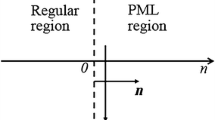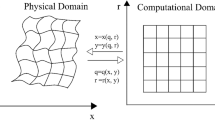Abstract
In seismic numerical simulations of wave propagation, it is very important for us to consider surface topography and attenuation, which both have large effects (e.g., wave diffractions, conversion, amplitude/phase change) on seismic imaging and inversion. An irregular free surface provides significant information for interpreting the characteristics of seismic wave propagation in areas with rugged or rapidly varying topography, and viscoelastic media are a better representation of the earth’s properties than acoustic/elastic media. In this study, we develop an approach for seismic wavefield simulation in 2D viscoelastic isotropic media with an irregular free surface. Based on the boundary-conforming grid method, the 2D time-domain second-order viscoelastic isotropic equations and irregular free surface boundary conditions are transferred from a Cartesian coordinate system to a curvilinear coordinate system. Finite difference operators with second-order accuracy are applied to discretize the viscoelastic wave equations and the irregular free surface in the curvilinear coordinate system. In addition, we select the convolutional perfectly matched layer boundary condition in order to effectively suppress artificial reflections from the edges of the model. The snapshot and seismogram results from numerical tests show that our algorithm successfully simulates seismic wavefields (e.g., P-wave, Rayleigh wave and converted waves) in viscoelastic isotropic media with an irregular free surface.















Similar content being viewed by others
References
Aki, K., & Richards, P. G. (2002). Quantitative seismology. Mill Valley: University Science Books.
Alterman, Z., & Karal, F. C, Jr. (1968). Propagation of elastic waves in layered media by finite difference methods. Bulletin of the Seismological Society of America, 58, 367–398.
Appelö, D., & Peterson, N. A. (2009). A stable finite difference method for the elastic wave equation on complex geometries with free surfaces. Communications in Computational Physics, 5, 84–107.
Carcione, J. M. (1993). Seismic modeling in viscoelastic media. Geophysics, 58, 110–120.
Carcione, J. M. (2007). Wave fields in real media: Wave propagation in anisotropic, anelastic, porous and electromagnetic media (Vol. 38). Oxford: Elsevier.
Carcione, J. M., Kosloff, D., & Kosloff, R. (1988a). Wave propagation simulation in a linear viscoacoustic medium. Geophysical Journal International, 93, 393–401.
Carcione, J. M., Kosloff, R., & Kosloff, D. (1988b). Viscoacoustic wave propagation simulation in the earth. Geophysics, 53, 769–777.
Carcione, J. M., Kosloff, D., & Kosloff, R. (1988c). Wave propagation simulation in a linear viscoelasric medium. Geophysics, 95, 597–611.
Drossaert, F. H., & Giannopoulos, A. (2007). A nonsplit complex frequency-shifted PML based on recursive integration for FDTD modeling of elastic waves. Geophysics, 72(2), T9–T17.
Emmerich, H., & Korn, M. (1987). Incorporation of attenuation into time domain computations of seismic wave fields. Geophysics, 52, 1252–1264.
Fan, N., Zhao, L., Xie, X., Ge, Z., & Yao, Z. (2016). Two-dimensional time-domain finite-different modeling for viscoelastic seismic wave propagation. Geophysical Journal International, 206, 1539–1551.
Hvid, S. L., 1994. Three dimensional algebraic grid generation. PhD Thesis, Technical University of Denmark.
Ilan, A. (1978). Stability of finite difference schemes for the problem of elastic wave propagation in a quarter plane. Journal of Computational Physics, 29, 389–403.
Ilan, A., & Loewenthal, D. (1976). Instability of finite difference schemes due to boundary conditions in elastic media. Geophysical Prospecting. https://doi.org/10.1111/j.1365-2478.
Kimentos, T. (1995). Attenuation of P and S-waves as a method of distinguishing gas and condensate from oil and water. Geophysics, 60, 447–458.
Komatitsch, D., & Tromp, J. (1999). Introduction to the spectral element method for three-dimensional seismic wave propagation. Geophysical Journal International, 139, 806–822.
Kosloff, D., & Carcione, J. M. (2010). Two-dimensional simulation of Rayleigh waves with staggered sine/cosine transforms and variable grid spacing. Geophysics, 75, T133–T140.
Kristek, J., & Moczo, P. (2003). Seismic-wave propagation in viscoelastic media with material discontinuities: A 3D fourth-order staggered-grid finite-difference modeling. Bulletin of the Seismological Society of America, 93, 2273–2280.
Kuzuoglu, M., & Mittra, R. (1996). Frequency dependence of the constitutive parameters of causal perfectly matched anisotropic absorbers. IEEE, 6, 447–449.
Lan, H., Chen, J., Zhang, Z., Liu, Y., Zhao, J., & Shi, R. (2016). Application of the perfectly matched layer in seismic wavefield simulation with an irregular free surface. Geophysical Prospecting, 64, 112–128.
Lan, H., & Zhang, Z. (2011). Three-dimensional wave-field simulation in Heterogeneous transversely isotropic media with irregular free surface. Bulletin of the Seismological Society of America, 101, 1354–1370.
Li, Y., & Matar, O. B. (2010). Convolutional perfectly matched layer for elastic second-order wave equation. The Journal of the Acoustical Society of America, 127, 1318–1327.
Liu, Y., & Sen, K. M. (2009). Advanced finite-difference methods for seismic modeling. Geohorizons, 14, 5–16.
Martin, R., Komatischa, D., & Ezziani, A. (2008). An unsplit convolutional perfectly matched layer improved at grazing incidence for the seismic wave equation in poroelastic media. Geophysics, 73, 51–61.
Matar, O. B., Preobrazhensky, V., & Pernod, P. (2005). Two-dimensional axi-symmetric numerical simulation of supercritical phase conjugation of ultrasound in active solid media. Journal Acoustic society of America, 118, 2880–2890.
Mavko, G., Dvorkin, J., & Walls, J. (2005). A rock physics and attenuation analysis of a well from the Gulf of Mexico. 75th Annual International Meeting, SEG, pp. 1585–1588.
Nilsson, S., Petersson, N. A., Sjogreen, B., & Kreiss, H. O. (2007). Stable difference approximations for the elastic wave equation in second order formulation. SIAM Journal on Numerical Analysis, 45, 1902–1936.
Robertsson, J. O. (1996). A numerical free-surface condition for elastic/viscoelastic finite-difference modeling in the presence of topography. Geophysics, 61, 1921–1934.
Robertsson, J. O., Blanch, J. O., & Symes, W. W. (1994). Viscoelastic finite difference modeling. Geophysics, 59, 1444–1456.
Roden, J. A., & Gedney, S. D. (2000). Convolutional PML(C-PML): An efficient FDTD implementation of the CFS-PML for arbitrary media. Microwave Optical Technology Letters, 27, 334–339.
Ruud, B., & Hestholm, S. (2001). 2D surface topography boundary conditions in seismic wave modelling. Geophysical Prospecting, 49, 445–460.
Saenger, E. H., & Bohlen, T. (2004). Finite-difference modeling of viscoelastic and anisotropic wave propagation using the rotated staggered grid. Geophysics, 69, 583–591.
Sun, Y., Zhang, W., & Chen, X. (2016). Seismic-wave modeling in the presence of surface topography in 2D general anisotropic media by a curvilinear grid finite-difference method. Bulletin of the Seismological Society of America, 106, 1036–1054.
Tal-Ezer, H., Carcione, J. M., & Kosloff, D. (1990). An accurate and efficient scheme for wave propagation in a linear viscoelastic medium. Geophysics, 55, 1366–1379.
Tessmer, E., & Kosloff, D. (1994). 3-D elastic modeling with surface topography by a Chebychev spectral method. Geophysics, 59, 464–473.
Thompson, J. F., Warsi, Z. U. A., & Mastin, C. W. (1985). Numercial grid generation foundations and applicatioins. New York: North Hollad Publishing Company.
Trifunac, M. D. (1971). Surface motion of a semi-cylindrical alluvial valley for incident plane SH waves. Bulletin of the Seismological Society of America, 61(6), 1755–1770.
Vidale, J. F., & Clayton, R. W. (1986). A stable free-surface boundary condition for two-dimensional elastic finite-difference wave simulation. Geophysics, 51, 2247–2249.
Virieux, J. (1986). P-SV wave propagation in heterogeneous media: Velocity-stress finite-difference method. Geophysics, 51, 889–901.
Xu, T., & McMechan, G. A. (1995). Composite memory variables for viscoelastic synthetic seismograms. Geophysical Journal International, 121, 634–639.
Yuan, S., Wang, S., Sun, W., Miao, L., & Li, Z. (2014). Perfectly matched layer on curvilinear grid for the second-order seismic acoustic wave equation. Exploration Geophysics, 45, 94–104.
Zeng, C., Xia, J., Miller, R. D., & Tsoflias, G. P. (2011). Application of the multiaxial perfectly matched layer (M-PML) to near-surface seismic modeling with Rayleigh waves. Geophysics, 76, T43–T52.
Zhu, T., & Sun, J. (2017). Viscoelastic reverse time migration with attenuation compensation. Geophysics, 83, S61–S73.
Acknowledgements
The authors acknowledge the Faculty Internationalization Grant at The University of Tulsa. The author, Dr. Fuping Liu, also thanks the support for this study from The Beijing City Board of Education Science and Technology Key Project (KZ201510015015), PXM2016_014223_000025, Beijing City Board of Education Science and Technology Project (KM201510015009), and Natural Science Foundation of Beijing (4142016). We appreciate William Sanger (Schlumberger) for English-polishing. Finally, thanks to two anonymous reviewers and to our editor Andrew Gorman for the valuable suggestions and comments.
Author information
Authors and Affiliations
Corresponding author
Appendices
Appendix A: Relationship Between Cartesian and Curvilinear Coordinates
The grid point \( \left( {x,z} \right) \) in Cartesian coordinates is determined from the grid point \( \left( {q,r} \right) \) in curvilinear coordinates with the equations:
The spatial derivatives in the Cartesian coordinate system can be obtained from the curvilinear coordinate system following the chain rule (Lan and Zhang 2011; Lan et al. 2016):
where \( q_{x} \), \( q_{z} \), \( r_{x} \) and \( r_{z} \) denote \( \partial_{q} \left( {x,z} \right)/\partial_{x} \), \( \partial_{q} \left( {x,z} \right)/\partial_{z} \),\( \partial_{r} \left( {x,z} \right)/\partial_{x} \) and \( \partial_{r} \left( {x,z} \right)/\partial_{z} \), respectively. Similarly, we can express the spatial derivatives in the curvilinear coordinate system \( \left( {q,r} \right) \) as
These kinds of derivatives are called metric derivatives (Lan and Zhang 2011):
where \( z_{r} \), \( z_{q} \), \( x_{r} \) and \( x_{r} \) denote \( \partial_{z} \left( {q,r} \right)/\partial_{r} \), \( \partial_{z} \left( {q,r} \right)/\partial_{q} \),\( \partial_{x} \left( {q,r} \right)/\partial_{r} \) and \( \partial_{x} \left( {q,r} \right)/\partial_{r} \), respectively. The Jacobian of the transformation \( J \) is given by
Appendix B: Viscoelastic Equations with the CPML Boundary Condition
The viscoelastic equations with the CPML boundary condition in curvilinear coordinates can be written as
where
In \( e_{1l} \), \( e_{11l} \), \( e_{12l} \) and in the viscoelastic equations (33)–(40), the first-order derivatives \( u_{q} \), \( u_{r} \), \( v_{q} \) and \( v_{r} \) are given by the following:
Appendix C: CPML Parameters
In the stretched-coordinate metrics, the parameters of the CPML in the \( q \) and \( r \) directions are (Komatitsch and Tromp 1999):
where \( N \) is a constant. \( N \) is normally set to 2. \( R \) is the theoretical reflection coefficient. Here we use \( R = 0.0001 \). \( L \) is the thickness of the CPML boundary. \( d_{q} \) and \( d_{r} \) are attenuation factors, and \( a_{q} \), \( a_{r} \), \( b_{q} \), and \( b_{r} \) are parameters used for the memory variables.
Rights and permissions
About this article
Cite this article
Liu, X., Chen, J., Zhao, Z. et al. Simulating Seismic Wave Propagation in Viscoelastic Media with an Irregular Free Surface. Pure Appl. Geophys. 175, 3419–3439 (2018). https://doi.org/10.1007/s00024-018-1879-9
Received:
Revised:
Accepted:
Published:
Issue Date:
DOI: https://doi.org/10.1007/s00024-018-1879-9




